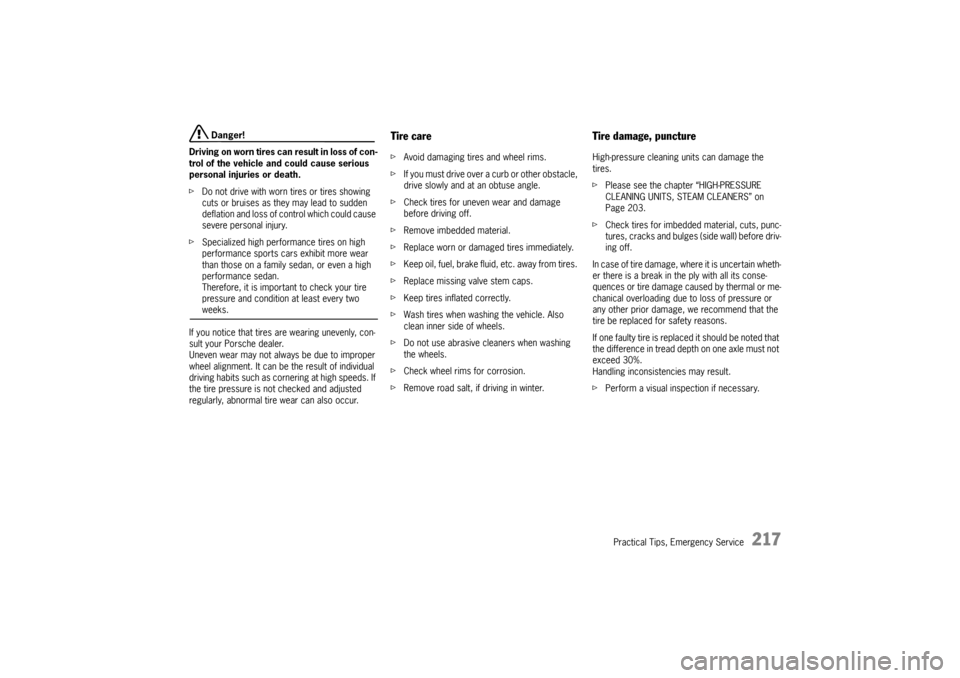2009 PORSCHE CAYMAN fuel cap
[x] Cancel search: fuel capPage 199 of 284

Maintenance, Car Care
197
Unleaded fuels may not be available outside the
continental U.S. and Canada. Therefore, we rec-
ommend you do not take your car to areas or
countries where unleaded fuel may not be availa-
ble. Octane ratings Octane rating indicates a fuel’s ability to resist det-
onation. Therefore, buying the correct octane gas
is important to prevent engine “damage”.
The RON octane rating is based on the research
method. The CLC (U.S. Cost of Living Council oc-
tane rating) or AKI ( anti knock index) octane rating
usually displayed on U.S. fuel pumps is calculated
as research octane numb er plus motor octane
number, divided by 2, that is written as:
The CLC or AKI octane rating is usually lower than
the RON rating:
For example: 95 RON equals 90 CLC or AKI
Fuels containing ethanolDo not use any fuels containing more than 10 per-
cent ethanol by volume.
We recommend, however, to change to a different
fuel or station if any of the following problems oc-
cur with your vehicle:
– Deterioration of driveability and performance.
– Substantially reduced fuel economy.
– Vapor lock and non-start problems, especially at high altitude or at high temperature.
– Engine malfunction or stalling. Portable Fuel Containers
Danger!
Portable fuel containers, full or partially
empty, may leak causing an explosion, or re-
sult in fire in case of an accident.
f Never carry additional fuel in portable contain-ers in your vehicle.
Fuel Evaporation Control Fuel tank venting The evaporation chamber and the carbon canister
prevent fuel from escaping to the atmosphere at
extreme high outside temperatures, when driving
abruptly around curves and when the car is parked
at an incline or in any other nonlevel position. Vapor control system and storage When the fuel tank is filled, vapors are collected in
the evaporation chamber by a vent line leading the
vapors to the carbon canister where they are
stored as long as the engine does not run. Purge system When the engine is running, the fuel vapors from
the canister will be mixed with fresh air from the
ambient air of the canister. This mixture will be
directed to the intake air housing by the tank vent
line, mixed with the intake air and burned during
normal combustion.
RON+MON
2
R+M
2
or
Page 217 of 284

Practical Tips, Emergency Service
215
Each tire, including the spare (if provided) should
be checked monthly when cold and inflated to the
inflation pressure recommended by the vehicle
manufacturer on the vehicle placard or tire infla-
tion pressure label. (If your vehicle has tires of a
different size than the size indicated on the vehicle
placard or tire inflation pressure label, you should
determine the proper tire inflation pressure for
those tires.)
As an added safety feature, your vehicle has been
equipped with a tire pressure monitoring (TPM)
that illuminates a low tire pressure telltale when
one or more of your tires is significantly under-in-
flated. Accordingly, when the low tire pressure tell-
tale illuminates, you should stop and check your
tires as soon as possible, and inflate them to the
proper pressure. Driving on a significantly under-
inflated tire causes the tire to overheat and can
lead to tire failure. Under-inflation also reduces
fuel efficiency and tire tread life, and may affect
the vehicle’s handling and stopping ability.
Please note that the TP M is not a substitute for
proper tire maintenance, and it is the driver’s re-
sponsibility to maintain correct tire pressure, even
if under-inflation has not reached the level to trig-
ger illumination of the TP M low tire pressure tell-
tale.
f On vehicles with tire pressure monitoring:
Please see the chapter “TPM TIRE PRESSURE
MONITORING” on Page 151.
When tires are warm, the tire pressure is
increased. f
Never let air out of hot tires.
This could cause the tire pressure to fall below
the prescribed value.
Insufficient tire filling pressure can cause tires to
overheat and thus be damaged – even invisibly.
Hidden tire damage is not eliminated by subse-
quently correcting the tire pressure.
Overloading
Danger!
Risk of damage to vehicle parts, loss of con-
trol and serious personal injury or death.
f Do not overload your vehicle. Be careful about
the roof load.
f If loading the vehicle also correct the tire pres-
sure. Tire pressure for loaded vehicle can be
found on the tire pressure plate and in the
chapter technical data.
f Never exceed the specified axle load.
Overloading can shorten the service life of the
tires and car, as well as lead to dangerous ve-
hicle reactions and long braking distances.
Damage due to overloading is not covered by the vehicle warranty.
f Please see the chapter “LOADING INFORMA-
TION” on Page 224.
f Please see the chapter “TIRE PRESSURE FOR
COLD TIRES (68 °F/ 20 °C)” on Page 267.
Example of a tire pressure plateTire pressure plateInformation on the tire pressure plate
A Seating capacity
Maximum number of vehicle occupants, inclu-
ding the driver.
Page 219 of 284

Practical Tips, Emergency Service
217
Danger!
Driving on worn tires can result in loss of con-
trol of the vehicle an d could cause serious
personal injuries or death.
f Do not drive with worn tires or tires showing
cuts or bruises as they may lead to sudden
deflation and loss of control which could cause
severe personal injury.
f Specialized high performance tires on high
performance sports cars exhibit more wear
than those on a family sedan, or even a high
performance sedan.
Therefore, it is important to check your tire
pressure and condition at least every two weeks.
If you notice that tires are wearing unevenly, con-
sult your Porsche dealer.
Uneven wear may not always be due to improper
wheel alignment. It can be the result of individual
driving habits such as cornering at high speeds. If
the tire pressure is not checked and adjusted
regularly, abnormal tire wear can also occur.
Tire care f Avoid damaging tires and wheel rims.
f If you must drive over a curb or other obstacle,
drive slowly and at an obtuse angle.
f Check tires for uneven wear and damage
before driving off.
f Remove imbedded material.
f Replace worn or damaged tires immediately.
f Keep oil, fuel, brake fluid, etc. away from tires.
f Replace missing valve stem caps.
f Keep tires inflated correctly.
f Wash tires when washing the vehicle. Also
clean inner side of wheels.
f Do not use abrasive cleaners when washing
the wheels.
f Check wheel rims for corrosion.
f Remove road salt, if driving in winter.
Tire damage, puncture High-pressure cleaning units can damage the
tires.
f Please see the chapter “HIGH-PRESSURE
CLEANING UNITS, STEAM CLEANERS” on
Page 203.
f Check tires for imbedded material, cuts, punc-
tures, cracks and bulges (side wall) before driv-
ing off.
In case of tire damage, where it is uncertain wheth-
er there is a break in the ply with all its conse-
quences or tire damage caused by thermal or me-
chanical overloading due to loss of pressure or
any other prior damage, we recommend that the
tire be replaced for safety reasons.
If one faulty tire is replaced it should be noted that
the difference in tread depth on one axle must not
exceed 30%.
Handling inconsistencies may result.
f Perform a visual inspection if necessary.
Page 273 of 284

Technical Data
271
Capacities Use only fluids and fuels authorized by Porsche. Your authorized Porsche dealer will gladly advise you.
Your Porsche has been designed so that it is not necessary to mix any additives with oils or fuels.
Engine Oil change quantity with oil filter approx. 1.98 U.S.gallons/7.5 liters
Please see the chapter “ENGINE OIL RECOMMENDATION” on Page 190.
Coolant Cayman: approx. 6.05 - 6.18 U.S. gallons/22.9 - 23.4 liters
Cayman S: approx. 6.13 - 6.61 U.S. gallons/23.3 - 25 liters
Manual transmission and differential Cayman: approx. 0.79 U.S. gallons/3 liters
Cayman S: approx. 0.85 U.S. gallons/3.2 liters
Porsche Doppelkupplung
Gear set approx. 0.78 U.S. gallons/2.95 liters
Porsche Doppelkupplung
Clutch/Hydraulic fluid approx. 1.37 U.S. gallons/5.2 liters
Power steering approx. 1.1 quarts/1 liter hydraulic fluid Pentosin CHF 11 S
® or CHF 202 S
®
Brake fluidapprox. 0.4 quarts/0.39 liters; use
only Original Porsche brake fluid
Windshield washer approx. 0.66 U.S. gallons/2.5 liters without headlight washer
approx. 1.58 U.S. gallons/6 liters with headlight washer
Fuel tank Refill volume approx. 16.9 U.S. gallons/64 liters, including approx. 2.6 U.S.gallons/10 liters reserve.
Fuel quality Your engine is designed to provide optimum performance and fuel economy using unleaded premium fuel with
an octane rating of 98 RON (93 CLC or AKI).
Porsche therefore recommends the use of these fuels in your vehicle.
Porsche also recognizes that these fuels may not always be available. Be assured tha t your vehicle will operate
properly on unleaded premium fuels with octane numbers of at least 95 RON (90 CLC or AKI), since the engine’s
”Electronic Octane™ knock control“ will adapt the ignition timing, if necessary.